As AI assistants evolve, GPT-5 and Claude Sonnet 4.5 stand out as the most capable large language models yet. Dive in and see how they stack up.
Keep reading
2025 has been a defining year for AI. OpenAI’s GPT-5 and Anthropic’s Claude Sonnet 4.5 have raised the bar once again, each one aiming to blend stronger reasoning, longer memory, and more autonomy into one seamless system. Both are built to handle coding, research, writing, and enterprise-scale tasks, yet their design philosophies differ sharply.
This breakdown explores how the two stack up across performance, reasoning, coding, math, efficiency, and cost, helping users and teams decide where each model truly shines.
A Quick Overview
Claude Sonnet 4.5 builds on Anthropic’s refined Claude family. It extends memory across sessions, handles million-token contexts via Amazon Bedrock and Vertex AI, and features smart context management that prevents sudden cut-offs. It can run autonomously for 30 hours on extended tasks, making it ideal for ongoing workflows.
Meanwhile, GPT-5 is OpenAI’s flagship successor to GPT-4, tuned for agentic reasoning, where the model plans, executes, and coordinates tools on its own. Its adaptive reasoning system dynamically chooses between shallow or deep “thinking” paths, letting users balance speed, cost, and depth per task. GPT-5 also offers specialized variants (Mini, Nano) for lighter workloads.
Reasoning and Analysis
Both models far exceed their 2024 counterparts, but they differ in how they reason.
GPT-5’s deep-reasoning mode significantly boosts performance in multi-step logic, scientific, and spatial tasks. It can break problems into chains, test sub-hypotheses, and self-correct mid-process. However, disabling this mode reduces accuracy sharply, it can be brilliant when “thinking deeply,” but more variable when not.
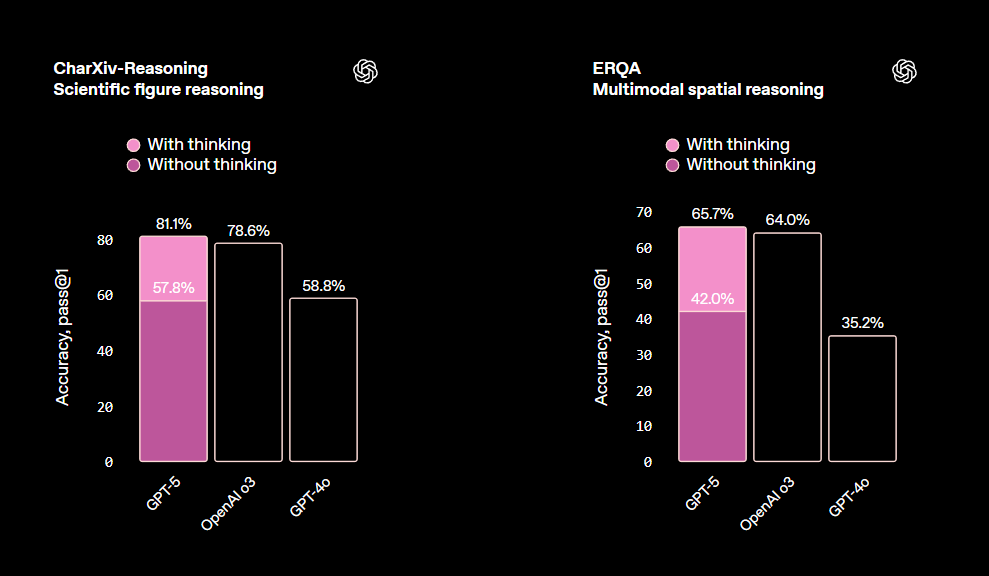
Claude Sonnet 4.5, by contrast, stays stable even without added configuration. It’s particularly strong in financial, policy, and business logic, where structure and coherence matter more than creative leaps. For enterprise Q&A or decision support, that predictability is valuable.

If you want an AI that reasons steadily, Claude takes the lead. If you need exploratory logic (i.e. complex hypothesis testing or cross-domain synthesis) GPT-5’s deeper path is unmatched.
Math and Structured Problem Solving
As seen in the benchmarks provided by Anthropic, Claude Sonnet 4.5 continues its consistency streak. Whether calculating directly or using Python tools, it achieves top-tier math accuracy. This means it handles structured logic even in constrained environments.
GPT-5 also reaches near-perfect accuracy, but only when tool use and reasoning depth are active. Disable them, and results drop noticeably. It relies heavily on its reasoning pipeline to stay sharp.
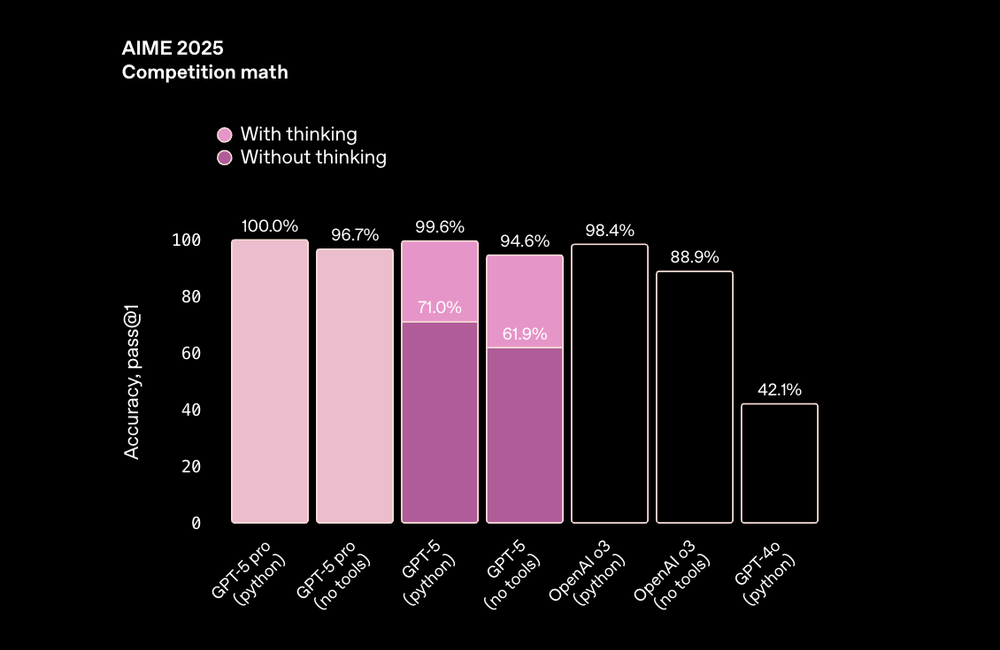
Verdict:
- Claude Sonnet 4.5: dependable out-of-the-box math solver.
- GPT-5: flexible but needs tuning to perform at its best.
Coding and Software Engineering
When it comes to coding, the two models diverge in style.
Claude Sonnet 4.5 delivers stable performance without special tuning. In tests resembling HumanEval+ and MBPP+, it maintains high accuracy across conditions, making it dependable for production pipelines. Its strength lies in consistency, results rarely fluctuate, which is crucial for enterprise use.

By contrast, GPT-5 achieves higher peak scores when its advanced reasoning is enabled, especially in multi-language or large-project contexts. In JavaScript and Python refactoring tasks, for instance, it outperformed Sonnet when its “high-reasoning” mode was active — though baseline runs without that mode varied more.
For agentic coding, where the AI calls external tools or terminals, Sonnet 4.5 often executes with fewer dropped commands. GPT-5, on the other hand, can chain more tool calls simultaneously, making it better for complex orchestration, provided you configure it carefully.
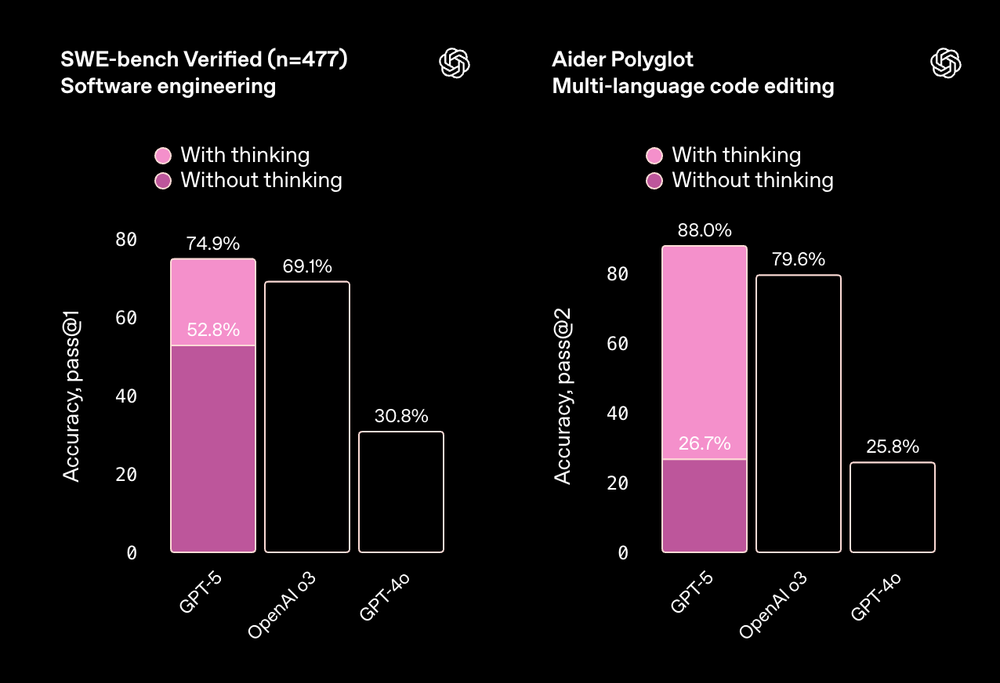
Verdict:
- Claude Sonnet 4.5: predictable, steady engineering partner.
- GPT-5: versatile powerhouse, but performance hinges on setup.
Cost and Efficiency
GPT-5 is clearly cheaper per token, particularly for large inputs. Its adaptive router also saves compute by running simple prompts on lighter paths.
Claude Sonnet 4.5 charges more but maintains predictable latency, a key factor for production environments that value reliability over marginal savings. For very large prompts, its cost rises faster than GPT-5’s, though batch discounts narrow the gap.
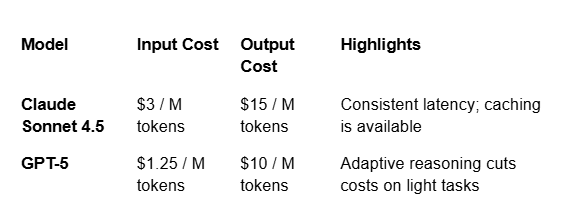
TL;DR: GPT-5 wins on price and scalability, whereas Claude wins on timing consistency and stability.
Pricing for Premium Plans
Beyond API access, both OpenAI and Anthropic offer premium subscriptions for individual users, which differ in features and pricing.
ChatGPT Plus, powered by GPT-5, is priced at $20 per month, giving users priority access to GPT-5, faster response times, and early access to new features and memory. OpenAI’s unified ChatGPT experience also includes file uploads, image generation, and custom GPTs.
Claude Pro, meanwhile, costs $20 per month as well and grants access to Claude Sonnet 4.5, offering faster responses, higher rate limits, and longer context windows. While it lacks built-in multimodal tools, Claude focuses on text clarity and structured reasoning, appealing to researchers, analysts, and writers seeking dependability over versatility.
TL;DR: both Plus plans are tied in price; what sets them apart, however, is their offering.
Different Strengths for Different Needs
It’s tempting to crown one “best,” but GPT-5 and Claude Sonnet 4.5 serve different priorities for different users and teams.
- Claude Sonnet 4.5: best for reliability and sustained performance. If you want consistent outputs and clear memory behavior, Claude delivers.
- GPT-5: best for depth, flexibility, and scalability. When configured properly, it surpasses rivals in creative reasoning, multimodal integration, and adaptive tool use.
Most teams may find the strongest setup is multi-model, using Claude where consistency matters most, and GPT-5 for data-intensive workflows.
Ultimately, these aren’t just chatbots anymore, they’re full-fledged digital collaborators, each with distinct personalities. Claude Sonnet 4.5 is your calm, methodical analyst. GPT-5 is your ambitious polymath. Which one you pick depends less on their individual benchmarks and more on your mission.
NEWS AND UPDATES

After a brutal October sell-off, crypto just staged one of its most dramatic comebacks yet. Here's what the market's resilience signals for what comes next.
The crypto market just pulled off one of its boldest recoveries in recent memory. What began as a violent sell-off on October 10 has given way to a surprisingly strong rebound. In this piece, we’ll dig into “The Great Recovery” of the crypto market, how Bitcoin’s resilience particularly stands out in this comeback, and what to expect next…
The Crash That Shook It All
On October 10, markets were rattled across the board. Bitcoin fell from around $122,000 down to near $109,000 in a matter of hours. Ethereum dropped into the $3,600 to $3,700 range. The sudden collapse triggered massive liquidations, nearly $19 billion across assets, with $16.7B in long positions wiped out.
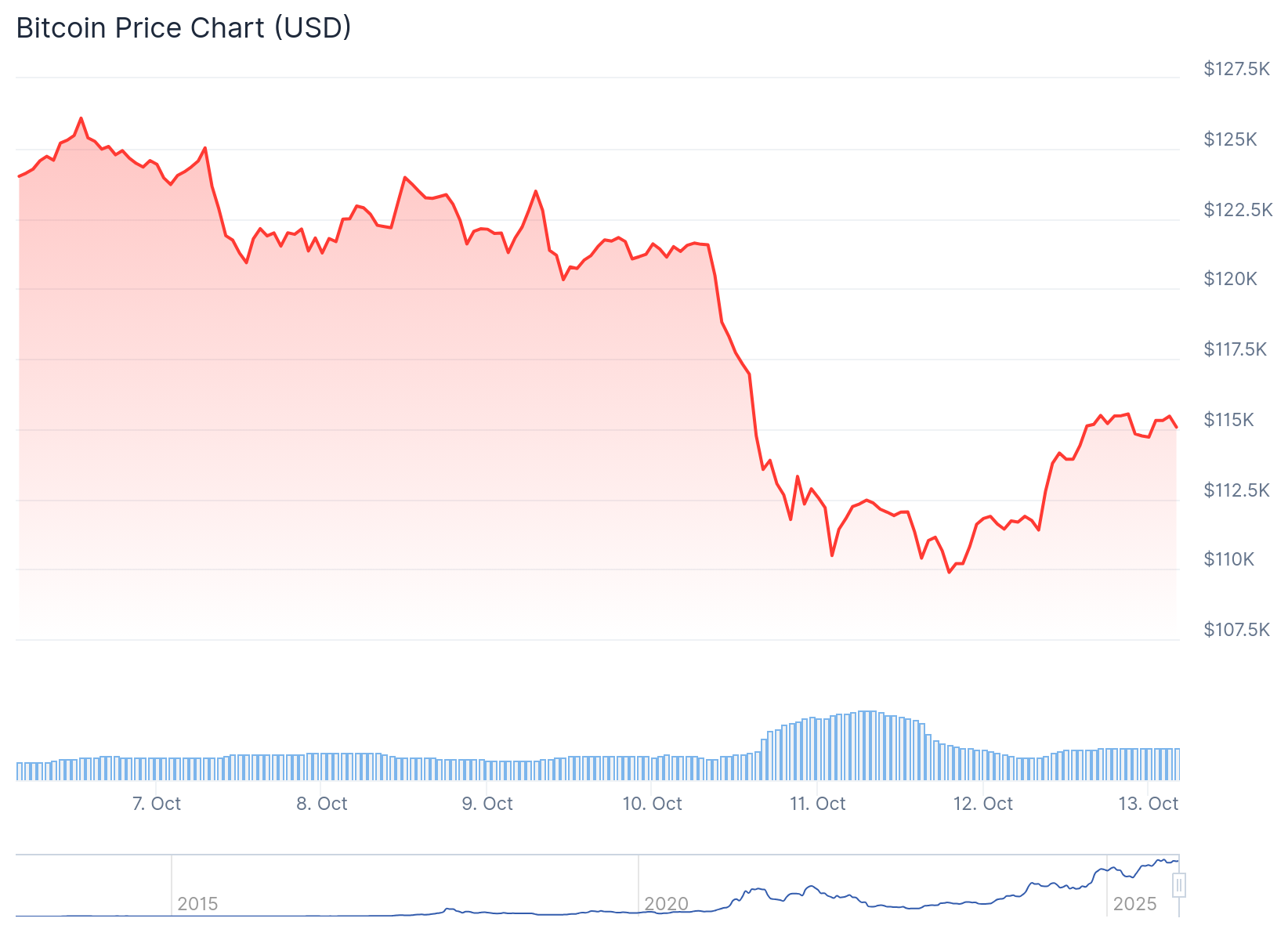
That kind of forced selling, often magnified by leverage and thin liquidity, created a sharp vacuum. Some call it a “flash crash”; an overreaction to geopolitical news, margin stress, and cascading liquidations.
What’s remarkable, however, is how quickly the market recovered.
The Great Recovery: Scope and Speed
Within days, many major cryptocurrencies recouped large parts of their losses. Bitcoin climbed back above $115,000, and Ethereum surged more than 8%, reclaiming the $4,100 level and beyond. Altcoins like Cardano and Dogecoin led some of the strongest rebounds.
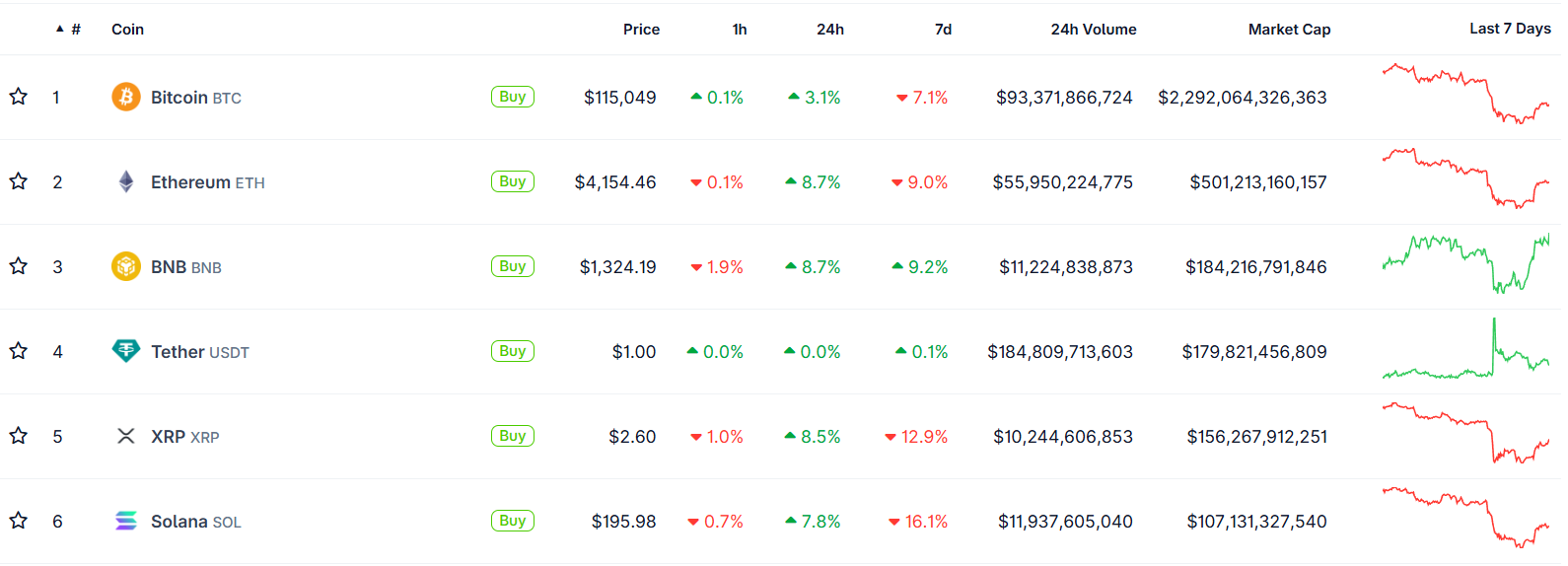
One narrative gaining traction is that this crash was not a structural breakdown but a “relief rally”, a market reset after overleveraged participants were squeezed out of positions. Analysts highlight that sell pressure has eased, sentiment is stabilizing, and capital is re-entering the market, all signs that the broader uptrend may still be intact.
“What we just saw was a massive emotional reset,” Head of Partnerships at Arctic Digital Justin d’Anethan said.
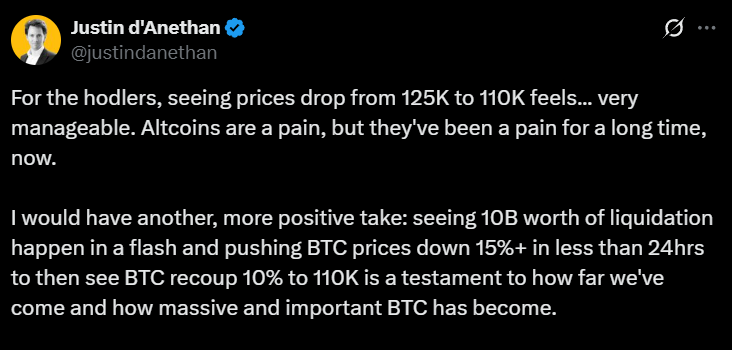
“I would have another, more positive take: seeing 10B worth of liquidation happen in a flash and pushing BTC prices down 15%+ in less than 24hrs to then see BTC recoup 10% to 110K is a testament to how far we've come and how massive and important BTC has become,” he posted on 𝕏.
Moreover, an important datapoint stands out. Exchange inflows to BTC have shrunk, signaling that fewer holders are moving coins to exchanges for sale. This signals that fewer investors are transferring their Bitcoin from personal wallets to exchanges, which is a common precursor to selling. In layman terms, coins are being held rather than prepared for trade.
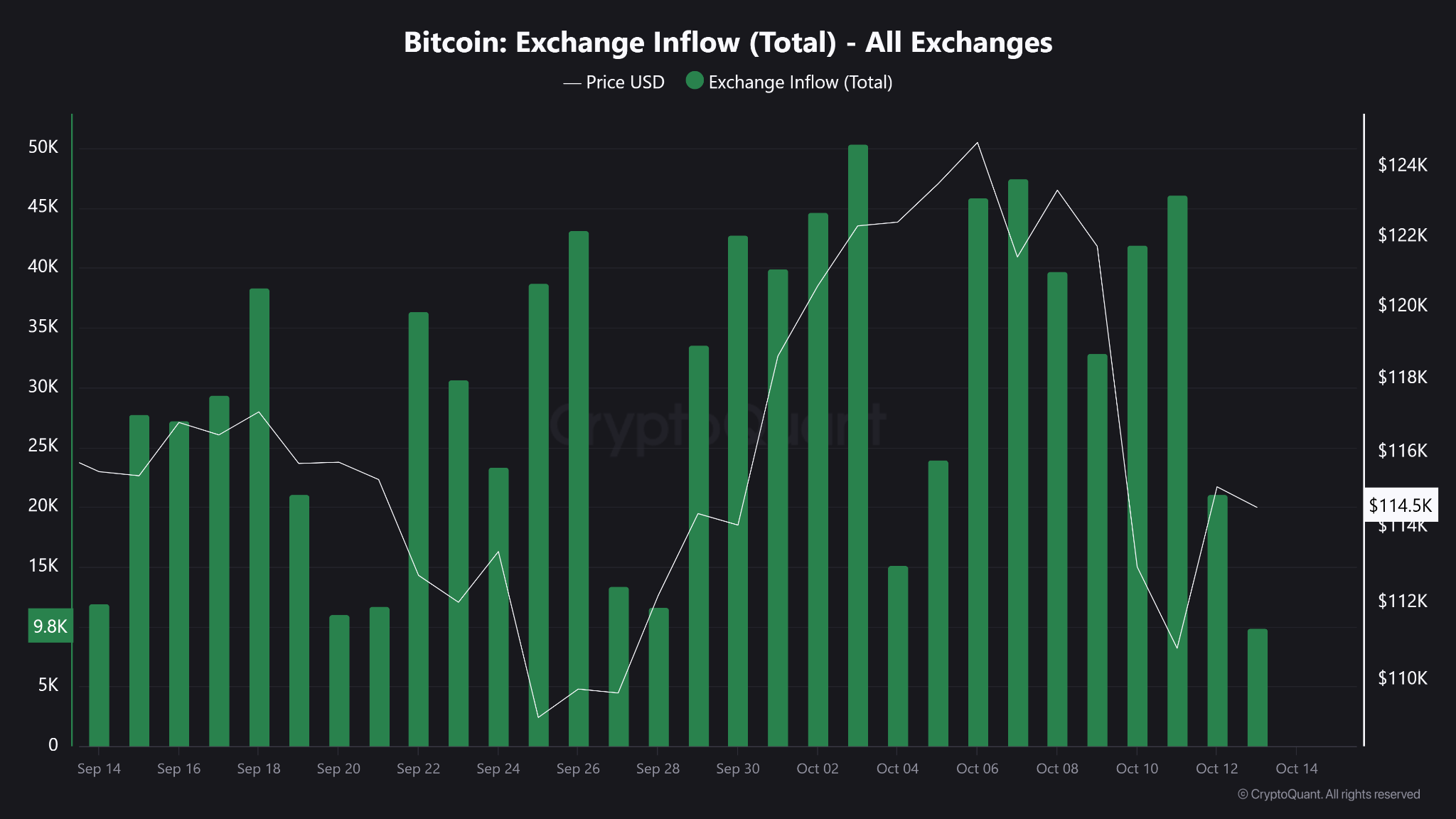
Bitcoin’s Backbone: Resilience Under Pressure
Bitcoin’s ability to rebound after extreme volatility has long been one of its defining traits. Friday’s drop admittedly sent shockwaves through the market, triggering billions in liquidations and exposing the fragility of leveraged trading.
Yet, as history has shown, such sharp pullbacks are far from new for the world’s largest cryptocurrency. In its short history, Bitcoin has endured dozens of drawdowns exceeding 10% in a single day (from the infamous “COVID crash” of 2020 to the FTX collapse in 2022) only to recover and set new highs months later.
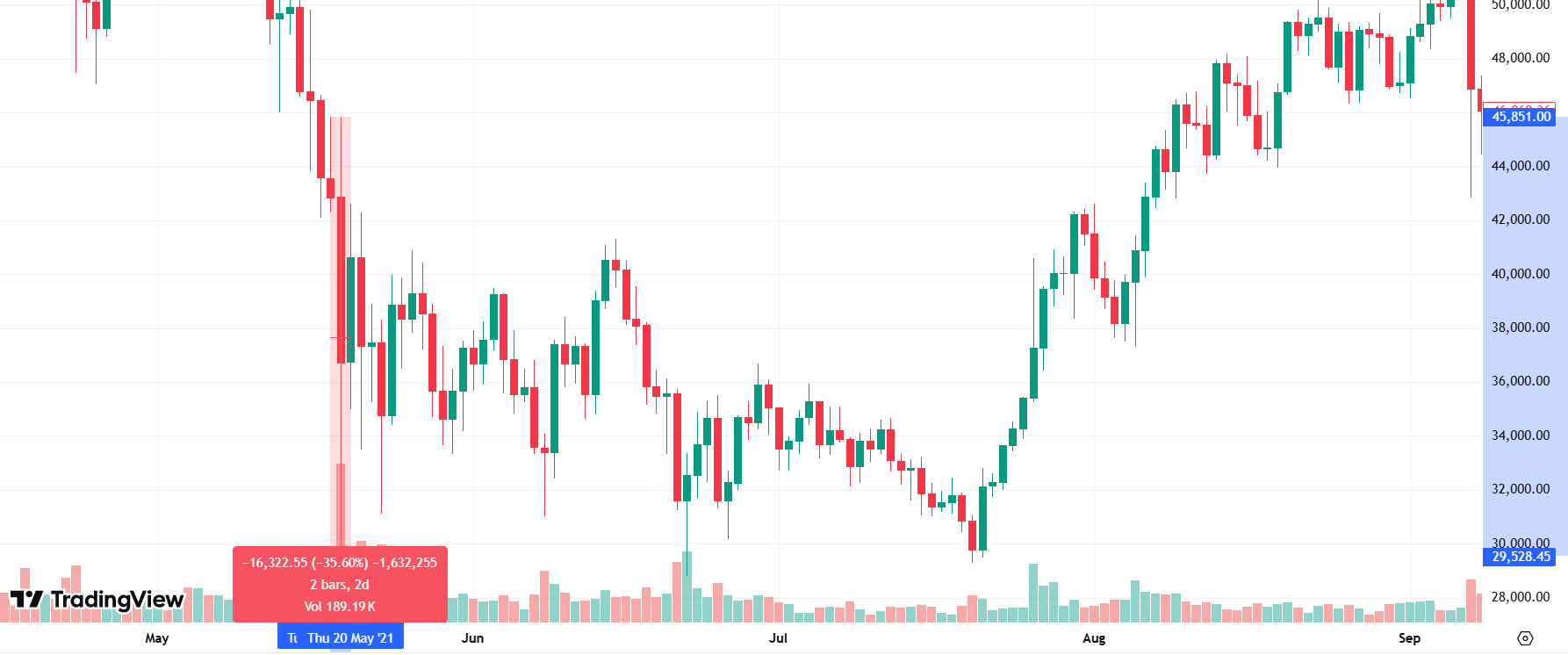
This latest event, while painful, highlights a maturing market structure. Since the approval of spot Bitcoin ETFs in early 2024, institutional involvement has deepened, creating greater liquidity buffers and stronger institutional confidence. Even as billions in leveraged positions were wiped out, Bitcoin has held firm around the $110,000 zone, a level that has since acted as psychological support.
What to Watch Next
The key question now is whether this rebound marks a short-term relief rally or the start of a renewed uptrend. Analysts are closely watching derivatives funding rates, on-chain flows, and ETF inflows for clues. A sustained increase in ETF demand could provide a steady bid under the market, offsetting the effects of future liquidation cascades. Meanwhile, Bitcoin’s ability to hold above $110,000 (an area of heavy trading volume) may serve as confirmation that investor confidence remains intact.
As the market digests the events of October 10, one lesson stands out. Bitcoin’s recovery isn’t just a matter of luck, it’s a reflection of underlying market structure that can absorb shocks. It is built on a growing base of long-term holders, institutional adoption, and a financial system increasingly intertwined with digital assets. Corrections, however dramatic, are not signs of weakness; they are reminders of a maturing market that is striding towards equilibrium.
Bottom Line
The crash on October 10 was brutal, there’s no denying that. It was one of the deepest and fastest in recent memory. But the recovery has been equally sharp. Rather than exposing faults, the rebound has underscored the market’s adaptability and Bitcoin’s central role.
The market consensus is seemingly leaning towards a reset; not a reversal. The shakeout purged excess leverage, and the comeback underlined demand. If Bitcoin can maintain that strength, and the broader market keeps its footing in the coming days, this could mark a turning point rather than a cave-in.

What's driving the crypto market this week? Get fast, clear updates on the top coins, market trends, and regulation news.
Welcome to Tap’s weekly crypto market recap.
Here are the biggest stories from last week (8 - 14 July).
💥 Bitcoin breaks new ATH
Bitcoin officially hit above $122,000 marking its first record since May and pushing total 2025 gains to around +20% YTD. The rally was driven by heavy inflows into U.S. spot ETFs, over $218m into BTC and $211m into ETH in a single day, while nearly all top 100 coins turned green.
📌 Trump Media files for “Crypto Blue‑Chip ETF”
Trump Media & Technology Group has submitted an S‑1 to the SEC for a new “Crypto Blue Chip ETF” focused primarily on BTC (70%), ETH (15%), SOL (8%), XRP (5%), and CRO (2%), marking its third crypto ETF push this year.
A major political/media player launching a multi-asset crypto fund signals growing mainstream and institutional acceptance, and sparks fresh conflict-of-interest questions. We’ll keep you updated.
🌍 Pakistan launches CBDC pilot & virtual‑asset regulation
The State Bank of Pakistan has initiated a pilot for a central bank digital currency and is finalising virtual-asset laws, with Binance CEO CZ advising government efforts. With inflation at just 3.2% and rising foreign reserves (~$14.5b), Pakistan is embracing fintech ahead of emerging-market peers like India.
🛫 Emirates Airline to accept crypto payments
Dubai’s Emirates signed a preliminary partnership with Crypto.com to enable crypto payments starting in 2026, deepening the Gulf’s commitment to crypto-friendly infrastructure.
*Not to take away from the adoption excitement, but you can book Emirates flights with your Tap card, using whichever crypto you like.
🏛️ U.S. declares next week “Crypto Week”
House Republicans have designated 14-18 July as “Crypto Week,” aiming for votes on GENIUS (stablecoin oversight), CLARITY (jurisdiction clarity), and Anti‑CBDC bills. The idea is that these bills could reshape how U.S. defines crypto regulation and limit federal CBDC initiatives under Trump-aligned priorities.
Stay tuned for next week’s instalment, delivered on Monday mornings.

Explore key catalysts driving the modern money revolution. Learn about digital currencies, fintech innovation, and the future of finance.
The financial world is undergoing a significant transformation, largely driven by Millennials and Gen Z. These digital-native generations are embracing cryptocurrencies at an unprecedented rate, challenging traditional financial systems and catalysing a shift toward new forms of digital finance, redefining how we perceive and interact with money.
This movement is not just a fleeting trend but a fundamental change that is redefining how we perceive and interact with money.
Digital Natives Leading the Way
Growing up in the digital age, Millennials (born 1981-1996) and Gen Z (born 1997-2012) are inherently comfortable with technology. This familiarity extends to their financial behaviours, with a noticeable inclination toward adopting innovative solutions like cryptocurrencies and blockchain technology.
According to the Grayscale Investments and Harris Poll Report which studied Americans, 44% agree that “crypto and blockchain technology are the future of finance.” Looking more closely at the demographics, Millenials and Gen Z’s expressed the highest levels of enthusiasm, underscoring the pivotal role younger generations play in driving cryptocurrency adoption.
Desire for Financial Empowerment and Inclusion
Economic challenges such as the 2008 financial crisis and the impacts of the COVID-19 pandemic have shaped these generations' perspectives on traditional finance. There's a growing scepticism toward conventional financial institutions and a desire for greater control over personal finances.
The Grayscale-Harris Poll found that 23% of those surveyed believe that cryptocurrencies are a long-term investment, up from 19% the previous year. The report also found that 41% of participants are currently paying more attention to Bitcoin and other crypto assets because of geopolitical tensions, inflation, and a weakening US dollar (up from 34%).
This sentiment fuels engagement with cryptocurrencies as viable investment assets and tools for financial empowerment.
Influence on Market Dynamics
The collective financial influence of Millennials and Gen Z is significant. Their active participation in cryptocurrency markets contributes to increased liquidity and shapes market trends. Social media platforms like Reddit, Twitter, and TikTok have become pivotal in disseminating information and investment strategies among these generations.
The rise of cryptocurrencies like Dogecoin and Shiba Inu demonstrates how younger investors leverage online communities to impact financial markets2. This phenomenon shows their ability to mobilise and drive market movements, challenging traditional investment paradigms.
Embracing Innovation and Technological Advancement
Cryptocurrencies represent more than just investment opportunities; they embody technological innovation that resonates with Millennials and Gen Z. Blockchain technology and digital assets are areas where these generations are not only users but also contributors.
A 2021 survey by Pew Research Center indicated that 31% of Americans aged 18-29 have invested in, traded, or used cryptocurrency, compared to just 8% of those aged 50-64. This significant disparity highlights the generational embrace of digital assets and the technologies underpinning them.
Impact on Traditional Financial Institutions
The shift toward cryptocurrencies is prompting traditional financial institutions to adapt. Banks, investment firms, and payment platforms are increasingly integrating crypto services to meet the evolving demands of younger clients.
Companies like PayPal and Square have expanded their cryptocurrency offerings, allowing users to buy, hold, and sell cryptocurrencies directly from their platforms. These developments signify the financial industry's recognition of the growing importance of cryptocurrencies.
Challenges and Considerations
While enthusiasm is high, challenges such as regulatory uncertainties, security concerns, and market volatility remain. However, Millennials and Gen Z appear willing to navigate these risks, drawn by the potential rewards and alignment with their values of innovation and financial autonomy.
In summary
Millennials and Gen Z are redefining the financial landscape, with their embrace of cryptocurrencies serving as a catalyst for broader change. This isn't just about alternative investments; it's a shift in how younger generations view financial systems and their place within them. Their drive for autonomy, transparency, and technological integration is pushing traditional institutions to innovate rapidly.
This generational influence extends beyond personal finance, potentially reshaping global economic structures. For industry players, from established banks to fintech startups, adapting to these changing preferences isn't just advantageous—it's essential for long-term viability.
As cryptocurrencies and blockchain technology mature, we're likely to see further transformations in how society interacts with money. Those who can navigate this evolving landscape, balancing innovation with stability, will be well-positioned for the future of finance. It's a complex shift, but one that offers exciting possibilities for a more inclusive and technologically advanced financial ecosystem. The financial world is changing, and it's the young guns who are calling the shots.

You might have heard of the "Travel Rule" before, but do you know what it actually mean? Let us dive into it for you.
What is the "Travel Rule"?
You might have heard of the "Travel Rule" before, but do you know what it actually mean? Well, let me break it down for you. The Travel Rule, also known as FATF Recommendation 16, is a set of measures aimed at combating money laundering and terrorism financing through financial transactions.
So, why is it called the Travel Rule? It's because the personal data of the transacting parties "travels" with the transfers, making it easier for authorities to monitor and regulate these transactions. See, now it all makes sense!
The Travel Rule applies to financial institutions engaged in virtual asset transfers and crypto companies, collectively referred to as virtual asset service providers (VASPs). These VASPs have to obtain and share "required and accurate originator information and required beneficiary information" with counterparty VASPs or financial institutions during or before the transaction.
To make things more practical, the FATF recommends that countries adopt a de minimis threshold of 1,000 USD/EUR for virtual asset transfers. This means that transactions below this threshold would have fewer requirements compared to those exceeding it.
For transfers of Virtual Assets falling below the de minimis threshold, Virtual Asset Service Providers (VASPs) are required to gather:
- The identities of the sender (originator) and receiver (beneficiary).
- Either the wallet address associated with each transaction involving Virtual Assets (VAs) or a unique reference number assigned to the transaction.
- Verification of this gathered data is not obligatory, unless any suspicious circumstances concerning money laundering or terrorism financing arise. In such instances, it becomes essential to verify customer information.
Conversely, for transfers surpassing the de minimis threshold, VASPs are obligated to collect more extensive particulars, encompassing:
- Full name of the sender (originator).
- The account number employed by the sender (originator) for processing the transaction, such as a wallet address.
- The physical (geographical) address of the sender (originator), national identity number, a customer identification number that uniquely distinguishes the sender to the ordering institution, or details like date and place of birth.
- Name of the receiver (beneficiary).
- Account number of the receiver (beneficiary) utilized for transaction processing, similar to a wallet address.
By following these guidelines, virtual asset service providers can contribute to a safer and more transparent virtual asset ecosystem while complying with international regulations on anti-money laundering and countering the financing of terrorism. It's all about ensuring the integrity of financial transactions and safeguarding against illicit activities.
Implementation of the Travel Rule in the United Kingdom
A notable shift is anticipated in the United Kingdom's oversight of the virtual asset sector, commencing September 1, 2023.
This seminal development comes in the form of the Travel Rule, which falls under Part 7A of the Money Laundering Regulations 2017. Designed to combat money laundering and terrorist financing within the virtual asset industry, this new regulation expands the information-sharing requirements for wire transfers to encompass virtual asset transfers.
The HM Treasury of the UK has meticulously customized the provisions of the revised Wire Transfer Regulations to cater to the unique demands of the virtual asset sector. This underscores the government's unwavering commitment to fostering a secure and transparent financial ecosystem. Concurrently, it signals their resolve to enable the virtual asset industry to flourish.
The Travel Rule itself originates from the updated version of the Financial Action Task Force's recommendation on information-sharing requirements for wire transfers. By extending these recommendations to cover virtual asset transfers, the UK aspires to significantly mitigate the risk of illicit activities within the sector.
Undoubtedly, the Travel Rule heralds a landmark stride forward in regulating the virtual asset industry in the UK. By extending the ambit of information-sharing requirements and fortifying oversight over virtual asset firms
Implementation of the Travel Rule in the European Union
Prepare yourself, as a new regulation called the Travel Rule is set to be introduced in the world of virtual assets within the European Union. Effective from December 30, 2024, this rule will take effect precisely 18 months after the initial enforcement of the Transfer of Funds Regulation.
Let's delve into the details of the Travel Rule. When it comes to information requirements, there will be no distinction made between cross-border transfers and transfers within the EU. The revised Transfer of Funds regulation recognizes all virtual asset transfers as cross-border, acknowledging the borderless nature and global reach of such transactions and services.
Now, let's discuss compliance obligations. To ensure adherence to these regulations, European Crypto Asset Service Providers (CASPs) must comply with certain measures. For transactions exceeding 1,000 EUR with self-hosted wallets, CASPs are obligated to collect crucial originator and beneficiary information. Additionally, CASPs are required to fulfill additional wallet verification obligations.
The implementation of these measures within the European Union aims to enhance transparency and mitigate potential risks associated with virtual asset transfers. For individuals involved in this domain, it is of utmost importance to stay informed and adhere to these new guidelines in order to ensure compliance.
What does the travel rules means to me as user?
As a user in the virtual asset industry, the implementation of the Travel Rule brings some significant changes that are designed to enhance the security and transparency of financial transactions. This means that when you engage in virtual asset transfers, certain personal information will now be shared between the involved parties. While this might sound intrusive at first, it plays a crucial role in combating fraud, money laundering, and terrorist financing.
The Travel Rule aims to create a safer environment for individuals like you by reducing the risks associated with illicit activities. This means that you can have greater confidence in the legitimacy of the virtual asset transactions you engage in. The regulation aims to weed out illicit activities and promote a level playing field for legitimate users. This fosters trust and confidence among users, attracting more participants and further driving the growth and development of the industry.
However, it's important to note that complying with this rule may require you to provide additional information to virtual asset service providers. Your privacy and the protection of your personal data remain paramount, and service providers are bound by strict regulations to ensure the security of your information.
In summary, the Travel Rule is a positive development for digital asset users like yourself, as it contributes to a more secure and trustworthy virtual asset industry.
Unlocking Compliance and Seamless Experiences: Tap's Proactive Approach to Upcoming Regulations
Tap is fully committed to upholding regulatory compliance, while also prioritizing a seamless and enjoyable customer experience. In order to achieve this delicate balance, Tap has proactively sought out partnerships with trusted solution providers and is actively engaged in industry working groups. By collaborating with experts in the field, Tap ensures it remains on the cutting edge of best practices and innovative solutions.
These efforts not only demonstrate Tap's dedication to compliance, but also contribute to creating a secure and transparent environment for its users. By staying ahead of the curve, Tap can foster trust and confidence in the cryptocurrency ecosystem, reassuring customers that their financial transactions are safe and protected.
But Tap's commitment to compliance doesn't mean sacrificing user experience. On the contrary, Tap understands the importance of providing a seamless journey for its customers. This means that while regulatory requirements may be changing, Tap is working diligently to ensure that users can continue to enjoy a smooth and hassle-free experience.
By combining a proactive approach to compliance with a determination to maintain user satisfaction, Tap is setting itself apart as a trusted leader in the financial technology industry. So rest assured, as Tap evolves in response to new regulations, your experience as a customer will remain top-notch and worry-free.
LATEST ARTICLE

If you’re thinking about incorporating crypto into your business or looking to better understand how digital currencies are infiltrating the business world, you’ll find everything you need to know on the topic below. Looking at the benefits these digital currencies can provide, as well as the downsides, we are effectively dissecting the concept of cryptocurrency in a traditional business model.
Each day we move into a more digital space, be it from the way we communicate to the way we pay for goods, there is no denying that the direction we’re headed in is digitally dominated. The evolution of money is taking a similar stride, from gold coins to banknotes to electronic transfers, and now, digital currencies.
Since the advent of Bitcoin, the world’s first cryptocurrency, over a decade ago, the world has embraced the new age payment system (even if it was one sector at a time). From early investors and developers to huge corporations, crypto has and continues to, infiltrate the financial sector. The recent Bitcoin futures ETF approval provides a classic example.
Crypto In Business
Since the global pandemic, Bitcoin (and the cryptocurrency industry) has edged itself into both the mainstream media as well as the corporate world. Following global market crashes, Bitcoin rose from the ashes and soared to reach unprecedented highs months later.
Many corporations looked to shift their company reserves from the devaluing US dollar to Bitcoin, instigating a massive wave of institutional involvement. Many big companies, everyone from PayPal to Wholefoods, started accepting (or facilitating the trade of) Bitcoin, and gradually crypto became less of a taboo in the Financial sector.
By the end of 2020, it is estimated that around 2,300 businesses in the United States had started accepting cryptocurrencies, alongside the 17,000 Bitcoin ATMs available across the country. As more businesses create teams to focus on the benefits of implementing cryptocurrency in their business, we’ve outlined the pros and cons of adopting the revolutionary technology.
The Pros Of Crypto In Business
For those not yet familiar with the benefits of crypto, or perhaps what it could do for companies (especially virtual and e-commerce ones), find the advantages that cryptocurrency can bring below:
• Removes The Middleman
The intent behind cryptocurrency creation was to establish a peer-to-peer payment system that circumvents the need for intermediary banks and financial establishments. This direct transactional approach results in diminished fees, quicker processing times, and a reduction in the often protracted paperwork and administrative formalities. Instead of relying on centralized entities, this payment system relies on a distributed network and a transparent, unchangeable ledger for its operational functionality.
• Fast, Secure Settlements
The network can facilitate international transactions in under an hour, for a fraction of the cost that fiat transactions cost. Using encrypted means of facilitating transactions, cryptocurrency networks are much more secure than any traditional bank.
• Increased User Engagement And Conversion Rates
The more payment options a company offers, the bigger the net of potential customers and conversion rates. The same is true for a wider range of currencies. By providing more options for customers to choose from, the wider the net of potential profit grows.
• Growth Potential
Change often leads to growth, particularly in saturated, highly competitive markets. Adopting and supporting crypto in business practices puts the company at the forefront of emerging technology, a space many will want to be as the world gets more digital.
• Lower Transaction Fees
Payment networks are notorious for charging high fees when receiving transactions, however, Bitcoin and other cryptocurrencies typically charge a much lower percentage. Tap has recently opened a channel for companies to conduct crypto business activities, and charges as low as 1.00% fees on transactions for business accounts.
The Cons Of Crypto In Business
Of course, there is always a downside to everything. Below we look at some of the risks associated with incorporating cryptocurrencies in business.
• Volatility
Cryptocurrencies have become synonymous with volatility, as the markets move to match supply and demand. Each market has been known to go through stages of increased price movement, however, analysts remain certain that while short term volatility is imminent, long term growth is on the cards.
• Consider Your Target Market
Not everyone has jumped on the crypto bandwagon so it is best to assess whether your clientele would be interested in such an option. If your business is catered to a predominantly older demographic then perhaps incorporating crypto as a payment option is not the best move.
• Security Is Your Responsibility
In the past, many people have lost their crypto portfolios due to lost private keys or hacks. With cryptocurrency, the onus lies on the holder to maintain adequate security measures in order to ensure the safety of the funds. Thankfully, Tap’s business section bypasses with cold storage of your cryptocurrencies assets and state of the art security.
Conclusion
After evaluating the advantages and disadvantages of incorporating cryptocurrency into your business, take a moment to determine if this decision aligns with your company's strategic direction. If you're considering integrating this modern payment system into your business operations, consider Tap as your solution to handle your requirements and provide the necessary infrastructure for the implementation of cryptocurrencies in your business.

Investing is not as easy as the internet makes it seem, with every profit comes plenty of research behind it. Not to mention all the strategies. Similar to trading, investing can at times be time-consuming and demanding. While investing, whether in the stock market or cryptocurrencies or any other asset classes, is beneficial in so many aspects, it can also come with some trial and error. In this article, we take a look at the time-tested dollar-cost averaging and explain why this is considered to be a low-risk strategy.
What is DCA?
DCA is an abbreviation for dollar-cost averaging. You may be wondering what DCA is? To put it simply, DCA is an investment strategy that sees people investing gradually over time rather than dropping a lump sum of money into assets.
Let's say an investor has a total of $10,000 to invest monthly, lump-sum investing would see them entering all that money into an asset market while DCA would have them investing $500 each week or month. Not only does DCA provide your leeway to pay your bills while still investing, but it also protects you from excess loss. While lump-sum investing does have its perks, it also has the potential for big losses.
By investing only what you are willing to lose, you are at no risk of financially crippling yourself. DCA ensures you do not lose all your money on an investment, whereas one wrong trade in lump sum trading can greatly set you back. DCA is a great way for newbies to test the markets and trust in an investment before moving forward, seasoned traders are also a fan of DCA as it allows them to diversify their funds in a more structured way.
The point of DCA is to avoid market watching and big losses, DCA is the practice of routinely investing smaller amounts, timed over regular intervals, regardless of price. This typically allows the investor to buy an asset at an average cost of a long period of time.
Why and how to use DCA
The how is easily answered, as already stated prior, it is as simple as allocating a set amount aside each month with the plan to invest. You invest your set amount a month routinely, regardless of the price, growing your total shares. But the real question is why? Why is this strategy so popular and why is it so highly recommended? Let's get into it.
The benefits right from the get-go are clear, you hold less risk of losing everything at once. As the traders' tale goes, only put in what you are willing to lose. Lump-sum investments do not take this approach with caution, putting it all on the line, or a large portion at least.
DCA means that you are continuously putting in small amounts that do not greatly limit your day-to-day life while still growing the value of your portfolio. DCA is a longer-term investment strategy. It also eliminates some of the risks involved with investing.
With DCA, the markets don't matter, you are buying your assets at whatever price they are at and reaping the profits when the price climbs. But also, by purchasing every week rather than all at once, you have the option and ability to buy in on the volatile markets getting better prices per share than someone who puts it all in at once.
This strategy also helps you manage emotional investing, forcing you to hold onto your investment despite FUD being spread, ensuring you don't sell low or buy high.
The DCA conclusion
While there are many investment strategies out there, this is a favoured strategy by many investors, that is not to say it is the only or best strategy, just one to consider. There are many perks that come with DCA, and that's what we wanted to highlight in this piece for you today. DCA provides a sense of commitment that is hard to find, ensuring you secure your space in the market without any added risks. There will always be risks involved with investing, but the DCA strategy finds some ways to minimise those risks in comparison.

You've likely heard a Bitcoin maximalist tell you that crypto is the future and will eventually replace fiat currencies. While that's unlikely to happen overnight or any time soon, we're exploring the question looking at many factors that will contribute to this tech-forward proposition.
While investor interest has certainly infiltrated mainstream culture, cryptocurrencies need to overcome several obstacles before they become a viable replacement. The obstacles include practical application, a willingness from merchants to embrace digital currencies, the market's volatility, and usability. Bearing that in mind, there have still been a number of shifts indicating that crypto adoption is certainly on the cards.
El Salvador Legalises Bitcoin
In June 2021, the president of the small Central American country, Nayib Bukele, announced that Bitcoin would officially be accepted as legal tender. The president also announced plans to create a Bitcoin City with the intention of becoming "the financial centre of the world.".
Rolling out a number of services to support this concept, including a national wallet named Chivo, the endeavour cost a large amount of taxpayers' money, and not all were happy about this.
On the other hand, Bukele was praised for being a revolutionary in the tech field, and a pioneer in the movement to shift from fiat to crypto. It's worth noting that there were mixed reactions on both sides of the crypto fence, some favouring the movement while others expressed concern over it being too premature.
New York Mayor Accepts Salary In Crypto
In a move to make New York City the crypto capital of the world, the current mayor, Eric Adams, has stuck to his word and accepted his salary in crypto. As part of his campaign, the politician promised to accept his first three paychecks in cryptocurrency and received his first instalment in a combination of Bitcoin and Ethereum in January.
Adams has also been vocal about his support for the NYC Coin, a digital currency that would take on similar functions as the Miami Coin released in 2021. Adams confirmed in a statement:
"New York is the centre of the world, and we want it to be the centre of cryptocurrency and other financial innovations. Being on the forefront of such innovation will help us create jobs, improve our economy, and continue to be a magnet for talent from all over the globe."
Rise In CBDCs
Venezuela is another country to adopt a pro-crypto attitude albeit born from less savoury conditions. Following a bout of hyperinflation, many turned to cryptocurrency as an alternative store of value, and as an income source as mining in the area with such low electricity prices was very lucrative.
This eventually led to the country creating its own digital currency, the Petro, released in 2018. Cryptocurrencies released by the government in this nature are referred to as central bank digital currencies, CBDCs.
The Bahamas and Nigeria also recently released their pilot central bank digital currencies to test the functionality and national responsiveness of the people. The "Sand Dollar" in The Bahamas is believed to be born from a combination of centralized banks being destroyed by hurricanes and accessibility to money across the various islands.
Nigeria confirmed that the move was in line with needing a more digital approach to finances as the country has a considerably young population (in 2020, 43% of the population was aged 0 - 14 years).
A number of other countries have also announced plans to "explore" CBDcs, with China also currently rolling out a pilot program in several cities across the country. Decentralized digital currencies play an advantageous role over fiat currencies in countries affected by corruption and with largely remote areas.
The Future Of Crypto
The future looks bright for the integration of cryptocurrencies into our traditional financial space. While it's unlikely that crypto will entirely replace fiat currencies (anytime soon or ever) it is likely that they can work alongside each other. With the rise in CBDCs around the world and the increase in mainstream crypto integration, the world has certainly taken notice of the vast benefits of using cryptocurrencies and the innovation in the space.
Tap remains ahead of the curve with its mobile app allowing users to pay for everything using cryptocurrencies from their portfolios. Simply select which cryptocurrency you would like to use and Tap will liquidate it for the local currency of the relevant account and send the required amount of fiat funds without any hassle for you. Simple and efficient, Tap is paving the way for the future.

Never underestimate the power of emotions and trading. While this might sound redundant, emotions play a much larger role in decision making than most might like to admit, and crypto trading is no exception. In order to make successful decisions, traders need to avoid the emotional rollercoaster and learn to look at the markets objectively.
Here we will show you how to master the emotional pitfalls of decision making when it comes to trading, a skill every successful trader has acquired at some point in their journey. Outlined below are several points one can incorporate into their trading practices, whether trading daily or once a month.
Outline Your Trading Goals
Before you implement any of these strategies into your trading practices, first establish what your trading goals are. Are you looking to make small returns on short term trades, or are you looking to make smart decisions over a long period of time? When it comes to mastering emotional management in trading you will need to ensure that every decision is in the best interests of your ultimate goal.
Black And White
Learn to remove the grey areas when it comes to decision making and view crypto trading in black and white, i.e. trade like a robot. By incorporating a systematic and rule-based approach to trading you can automatically alleviate the grey areas, this might include algorithms and computer-executed trading strategies.
Red Light, Green Light
Colours play a huge role in our psyche and can often trigger an emotional response. For instance, if you see a big red candle this will likely stir feelings attached to danger, stopping and signs of warning. Don’t fall into the trap of allowing this to trigger you, and the same goes for seeing green candles. Don’t allow these colours to trigger your emotions and make decisions that deviate from your end goal.
Axiomatic Framework
Solidify a set of rules for your trading practices that provide unquestionable pathways through which you can trade. For example, set up entries, exits, risk limits and stop orders. Also look at establishing rules in advance around when to exit a trade if it moves favourably or unfavourably, and what your risk parameters are.
If a trade does not entirely meet all the predetermined criteria you established, do not enter a trade.
Take A Break
If you’re on a bad streak, consider taking a break from trading activities to re-centre. This practice is used by risk managers on trading floors and is referred to as cut-offs. If a trader is experiencing a poor performance streak they will be moved to a demo trading model until they start to perform better, this also might include taking a break completely.
Self Reflect On Behavioural Shortcomings
Dig deep to find what reactions you make when faced with emotions such as greed or fear. Attempt to learn as much as possible about your behavioural patterns when trading so that once triggered you can learn to recognise these patterns so as not to fall victim to your own emotional responses.
Balance
Don’t underestimate the power of balance as it plays an imperative role when it comes to clear judgement, reason and logic. When it comes to being a strong athlete, it’s imperative that the athlete needs to be in a good mental space too. The same runs true for being a strong trader, mental (and even physical) strength plays a strong role in overall balance and your ability to function optimally. These positive changes reverberate across all aspects of your life and can certainly have an effect on your trading endeavours.
Master Emotional Management In Trading
Ultimately the most disciplined version of yourself will yield the best results when it comes to trading. Consider improving on all aspects of your life and then implement several strategies listed above and you should be well on your way to an incredibly successful trading path.
To learn more about this topic, consider reading “Trading in the Zone” by Mark Douglas and “The Psychology of Trading” by Brett N. Steenbarger.

Bitcoin wallets are responsible for not only storing the digital asset but also providing access to the funds and allowing traders to conduct transactions. Whether you're buying Bitcoin for the first time or have been investing in the blockchain-based currency for years, understanding how a Bitcoin wallet works will assist you in developing and improving your trading experience.
In this guide, we're going to assist you in understanding what a Bitcoin wallet is, how they work, and where you can find the best one in the United Kingdom. Because where you store your money has become part of the Tap services that we offer.
What is a Bitcoin Wallet?
A Bitcoin wallet not only stores your digital asset but also facilitates the sending and receiving of BTC. While traditional wallets simply provide a means to store your money, crypto wallets are a more complex product providing more functionality to the user. The digital wallet connects to the blockchain and enables you to conduct transactions, keeps track of your balance, and acts as a "decentralized bank account".
There are different types of Bitcoin wallets with some being referred to as hot wallets while others are cold wallets. Hot wallets are simply cryptocurrency wallets that are connected to the internet, while cold wallets are only connected briefly when conducting trades. Wallets connected to the internet are more vulnerable to hacking, hence cold wallets being a more viable option when storing cryptocurrencies long term.
Cold wallets can come in the form of physical hardware, like a USB device, or merely a piece of paper (known as a paper wallet). Most wallets come free however hardware wallets you will need to purchase.
How does a Bitcoin wallet work?
As we mentioned earlier, Bitcoin wallets connect to the blockchain of the network. Each wallet is represented by a 26 character alpha-numeric code, known as your public key, which acts as your wallet address allowing anyone to send you Bitcoin and identify you on the blockchain.
Each wallet also comes with a private key, which is essentially the "pin code" to your wallet. This code gives you access to your wallet, allowing you to access and send crypto, and should not be shared with anyone. If someone were to gain access to your private keys, they would have control over your funds.
The Bitcoin blockchain uses the public keys to track Bitcoin transactions, with each wallet representing a BTC balance, and the network receiving updated copies of this. So while Bitcoin wallets don't actually "store" the digital currency, they hold a record of the current balance and previous transactions. As BTC is sent and received, the blockchain records and updates the ownership of each cryptocurrency as well as the wallets' balances.
What types of Bitcoin wallets UK are available?
There are several options available for Bitcoin wallets in the UK which we'll take a look at below. Crypto wallets fall into two categories - hot wallets and cold wallets - and will differ for each cryptocurrency. I.e. you cannot store Bitcoin in an Ethereum wallet, as each connects to a different blockchain. Bitcoin must be stored in a Bitcoin wallet and Ethereum in an Ethereum wallet.
Hot Wallets
Hot wallets are constantly connected to the internet and provide fast access to your Bitcoin portfolio. There are three main types of hot wallets:
- - Desktop wallet, applications on a desktop
- - Mobile wallet, applications on a mobile device
- - Web wallet, applications accessed through a web browser
While these wallets are known to be more vulnerable to hacking, they are the best options for someone looking to day trade.
Cold Wallets
These types of wallets are considered to be more secure as they are not constantly connected to the internet. There are two main types:
- - Hardware wallet, an external device that uses USB or Bluetooth
- - Paper wallet, where public and private keys are printed onto a piece of paper
When looking to make transactions, you will need to connect the cold wallet to a hot wallet. For instance, hardware wallets will come with hot wallet applications for desktop or mobile that, once connected, can facilitate transactions. Paper wallets also require a hot wallet to conduct the transactions.
An example of a hardware wallet is a Ledger Nano S, which allows you to open an account and provides both app and device to assist you in securely storing your crypto. Cold wallets are best suited for long term hodling.
Finding the best Bitcoin wallet UK
Finding the best Bitcoin wallet in the UK needn't be a tiresome task as we have you covered with the Tap app. While the app is conveniently downloaded to mobile devices, traders can carry their cryptocurrency anywhere, with much greater security than other cryptocurrency apps on phones.
While we've redesigned the tech behind traditional mobile wallets, we've also made things easier by allowing you to use a password of your choice. With an easy to navigate interface, and all your balances stored on one page, the Tap app is every trader's dream.
Our Tap wallet allows you to store both crypto and fiat currencies and uses a hybrid of both hot and cold wallet technology to ensure that they are always highly secure, and always available.
Security and convenience are key
If you're searching for a reliable Bitcoin wallet option in the UK, you'll discover it conveniently with the Tap app. Simply download the Tap app, set up an account, complete the KYC verification, and you'll have the opportunity to securely manage your cryptocurrencies with top-notch security features that are available on the market.

När man pratar om att investera i kryptovalutor tänker många antingen på att köpa och hålla krypto – eller på mining. Men visste du att det finns ett annat sätt att tjäna på dina innehav, helt utan att sälja något? Det kallas staking – och det kan ge dig avkastning på dina kryptotillgångar, helt passivt.
Här förklarar vi allt du behöver veta för att komma igång med staking – även om du är nybörjare. Låt oss dyka in.
Vad är staking?
Staking innebär att du låser dina kryptovalutor i en digital plånbok under en viss tid – och som tack får du belöningar. Du hjälper helt enkelt till att verifiera transaktioner och hålla igång blockkedjan. I gengäld får du betalt, ofta i form av samma kryptovaluta.
Det här bygger på en konsensusmodell som kallas Proof-of-Stake (PoS). I motsats till mining – där datorer tävlar om att lösa matematiska problem – handlar staking om att du bevisar ditt engagemang genom att låsa dina tillgångar.
När du deltar i staking är du alltså med och verifierar transaktioner och stärker säkerheten i nätverket.
Hur fungerar staking?
För dig som användare är staking en passiv process. När du stakar dina tillgångar – det vill säga låser dem i din plånbok – används de av nätverket för att skapa nya block på blockkedjan.
Ditt innehav används som en form av säkerhet, vilket gör att du kan bli vald att verifiera block. När det händer får du en belöning – ungefär som ränta.
Du kan ofta själv välja hur länge du vill låsa dina tillgångar, från några timmar till flera månader eller år. Ju längre du stakar, desto högre blir vanligtvis belöningen.
Fördelar och nackdelar med staking
✅ Fördelar:
- Passiv inkomst – du tjänar medan dina tillgångar ligger still
- Enkelt att komma igång – kräver inga avancerade kunskaper
- Låga eller inga avgifter – många plattformar erbjuder staking direkt i appen
- Hållbart alternativ till mining – energisnålt jämfört med Proof-of-Work
⚠️ Att tänka på:
- Värdevolatilitet – om värdet på valutan faller kan även din belöning minska
- Låst kapital – du kommer inte åt dina stakade tillgångar under perioden
- Olika belöningar – staking-belöningen varierar beroende på vilken valuta och plattform du använder
Är staking lönsamt?
Ja, staking kan vara lönsamt – särskilt för den som redan har kryptotillgångar som stöder staking. Det fungerar ungefär som ränta på ett sparkonto, där du får belöningar baserat på hur mycket och hur länge du stakar.
Om värdet på kryptovalutan ökar under tiden du stakar kan vinsten bli ännu större. Men tänk på att värdet också kan sjunka, vilket kan minska eller till och med äta upp vinsten från staking.
Sammanfattning: vad är staking?
Staking är ett sätt att använda dina kryptotillgångar för att tjäna belöningar och stötta nätverket – ungefär som att få utdelning på aktier eller ränta på ett sparkonto.
Du behöver inte göra något aktivt – bara hålla dina coins på rätt plats under en viss tid. I gengäld får du belöningar från nätverket.
Kickstart your financial journey
Ready to take the first step? Join forward-thinking traders and savvy money users. Unlock new possibilities and start your path to success today.
Get started